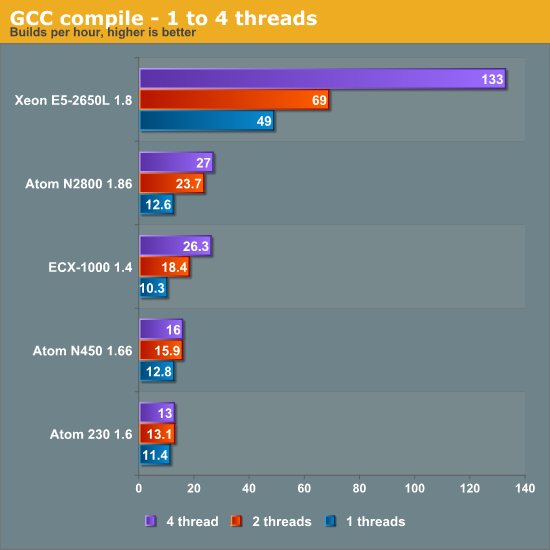Calxeda's ARM server tested
by Johan De Gelas on March 12, 2013 7:14 PM EST- Posted in
- IT Computing
- Arm
- Xeon
- Boston
- Calxeda
- server
- Enterprise CPUs
Building and Compiling
We compiled the 7z source by performing a make -jx (with x being the number of threads). Compiling is branch intensive (22%) workload that does mostly loads and stores (about 40%).
Looking at the single-thread performance, the ARM Cortex-A9 and Atom are in the same ballpark. This is the kind of workload where the Sandy Bridge core of the Xeon really shines. You need about eight Cortex-A9 cores to beat one Xeon (without HT). And it must be said: compiling inside a virtual machine on top of the Xeon E5 is a very pleasant experience compared to the long wait times on the Atom and ECX.

Lessons so Far
A quad-core Cortex-A9 performs well in server workloads that are mostly memory latency sensitive. A quad-core Cortex-A9 ECX-1000 at 1.4GHz has no trouble competing with Atoms at slightly higher clockspeeds (1.6GHz). There is only one exception: bandwidth intensive workloads.
Both Atom and ARM based servers have the disadvantage of being rather slow in typical "management" tasks such as compiling, installing, and updating new software. Compiling a rather simple piece of software in a VM with only two Xeon vCPUs (running on one 1 core + HTT) took only 37 seconds. A single-core Atom server needed 275 seconds, while the quad-core ARM ECX-1000 needed 137 seconds.
But the Boston Viridis is much more than just a chassis with 24 server nodes. It has a high performance switching fabric. So it's time to see what this server can do in a real server environment.










99 Comments
View All Comments
Madpacket - Wednesday, March 13, 2013 - link
And all of a sudden AMD's acquisition of SeaMicro is starting to make sense. Thanks Johan, great article!JohanAnandtech - Wednesday, March 13, 2013 - link
I really really hope they downscale the current SeaMicro's soon. Because with a starting price at $139000, they are not catering to the typical SME :-).joshv - Wednesday, March 13, 2013 - link
It seems this has a very narrow application in VM hosting, but I am not sure it's applicable when you have the choice of just scaling up memory or process usage of the single instance Xeon server. For example, I could load 24 instances of my production middle tier on the ARM server - or I could run one instance on a Xeon server and give it all the memory and make sure it spawns enough threads to keep all the internal cores busy. Perhaps my middle tier software has issues with handling all that RAM, so maybe I run 4 instances of it as a process, not a biggy.I am going to bet that the Xeon server will win as it won't have the VM overhead.
Kurge - Wednesday, March 13, 2013 - link
I would be interested in a bare metal comparison. Since you're serving up the same app why would you split it between 24 VMs on the Xeon server? It's a bit contrived.Just load up Server 2012 and IIS or Linux + Apache straight up on the Xeon and see how it performs.
MrSpadge - Wednesday, March 13, 2013 - link
Very interesting!I'd prefer a fat machine with virtualized servers to get automatic load balancing, but it's not like one couldn't shuffle tasks around in the ARM farm. And there's room for improvement: be it the next Atom or the memory controller in the current ECX-1000 CPUs. And take a look at how badly they scale from 2 to 4 threads - surely, there's lot's of rooms left!
rubyl - Wednesday, March 13, 2013 - link
What is the average CPU utilization for the Viridis nodes and for the Xeon system under the 5 different concurrency loads (for the 24 webserver workload)?gercho - Wednesday, March 13, 2013 - link
When you said " The next generation ARM servers are already on the way and will probably hit the market in the third quarter of this year. The "Midway" SoC is based on a 28nm (TSMC) Cortex-A15 chip. A 28nm A15 offers 50% higher single-threaded integer performance at slightly higher power levels and can address up to 16GB of RAM." As far as I know the A15 cores have 50% more performance but consume 3X more power, that's not "slightly".........nofumble62 - Wednesday, March 13, 2013 - link
50% more performance at 3X more power... reminding me of the Netburst architect.thenewguy617 - Wednesday, March 13, 2013 - link
Can you please point me to sources of your number?Thanks
Wilco1 - Thursday, March 14, 2013 - link
Where on earth you do get that 3x from? So far no 28nm Cortex-A15 chips have been released. The A15 in the Exynos Octo uses about 1.25W per core at 1.8GHz according to Samsung. That's slightly more power than a Calxeda A9 uses per core, but the A15 gives twice the performance per core.